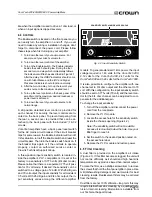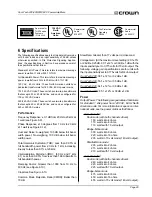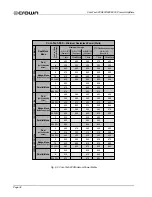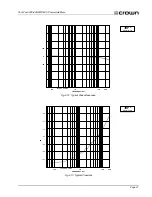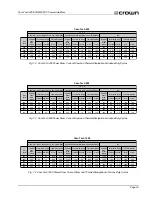
Page 36
Com-Tech 200/400/800/1600 Power Amplifiers
Maximum Power Specifications
Crown’s maximum power specifications represent the largest amount of output power you can expect from your amplifier
when it is driven to full output under the given conditions. These specifications can be used to prevent loudspeaker and
hearing damage.
The maximum power matrices include specifications for single cycle and 40 millisecond burst sine waves. Burst signals
act like large transient peaks that are present in common source signals. Loudspeakers can respond to a single cycle
burst, so the single cycle burst specifications should be used to help you protect your loudspeakers. In contrast, a
40 millisecond burst represents the typical response time of the human ear. Your ear will not respond to the entire
dynamic change of a burst that lasts less than 40 milliseconds.
The burst power specifications are provided at 0.05% THD which is a practical low distortion condition. Operating the
amplifier at levels higher than 0.05% THD can result in output power levels that are higher than those listed in the
maximum power matrices.
Fig. 6.5 Com-Tech 200 Maximum Power Matrix
Maximum Power Notes:
All maximum power specifi-
cations are based on 0.5%
regulated AC mains with
THD of less than 1.0% and
an ambient room tempera-
ture of 70° F (21° C). Al-
though it is an unusual con-
dition, your amplifier can
function well with AC mains
voltages up to 10% over the
specified line voltage. With
overvoltage conditions, your
amplifier may be capable of
delivering instantaneous
power levels up to 20%
greater than the specifica-
tions in the matrix.
1. A single cycle sine wave
is presented to the ampli-
fier and monitored for
nonlinear distortion. The
average power during the
burst is reported. Loud-
speakers must be able to
withstand this level if they
are to be safely used with
this amplifier.
2. A 40 millisecond sine wave
burst (10 percent duty
cycle) is presented to the
amplifier and monitored for
nonlinear distortion. Aver-
age power during the
burst is reported. This
power level is a measure-
ment of the amplifier’s
maximum transient power
that can be perceived by
the human ear.
50 (70V)
4
Dual
(both channels
driven)
Bridge-Mono
(balanced output)
Parallel-Mono
2
100 (140V)
8
25 (70V)
155
115
125
310
225
250
300
220
245
175
130
130
345
250
255
345
245
255
170
130
130
355
255
255
345
255
255
205
145
135
400
280
270
405
280
270
275
165
140
535
325
275
520
315
280
8
4
16
Dual
(both channels
driven)
Bridge-Mono
(balanced output)
Parallel-Mono
165
125
135
325
245
265
310
235
265
165
120
130
325
240
255
315
230
255
175
130
140
345
255
275
335
250
275
190
135
140
380
265
275
360
265
275
165
125
140
325
250
275
325
245
275
220
155
150
435
300
295
425
305
295
310
185
150
600
360
305
580
355
305
Com-Tech 200 –
Maximum Power (Watts)
Dual/Mono
Mode
40 Millisecond Tone Burst
At 0.05% THD
(See note 2)
Single Cycle Tone Burst
At less than 0.05% THD
(See note 1)
50 Hz
1 kHz
Load in Ohms
(Constant Voltage)
20 Hz
50 Hz
1 kHz
275
165
135
530
320
265
520
315
265
305
180
145
605
360
290
585
355
290
7 kHz
7 kHz
AC Mains
120 VAC, 60 Hz
100/120 VAC, 50/60 Hz
Dual
(both channels
driven)
Bridge-Mono
(balanced output)
Parallel-Mono
165
125
135
325
245
310
315
240
270
175
130
140
345
260
300
335
255
280
190
140
140
375
270
310
370
270
280
165
130
140
330
250
305
315
250
280
225
155
150
440
310
310
425
305
295
315
185
155
625
370
315
595
365
305
310
185
150
625
370
300
590
360
295
220/240 VAC, 50/60 Hz
50 (70V)
4
2
100 (140V)
8
25 (70V)
8
4
16
50 (70V)
4
2
100 (140V)
8
25 (70V)
8
4
16




